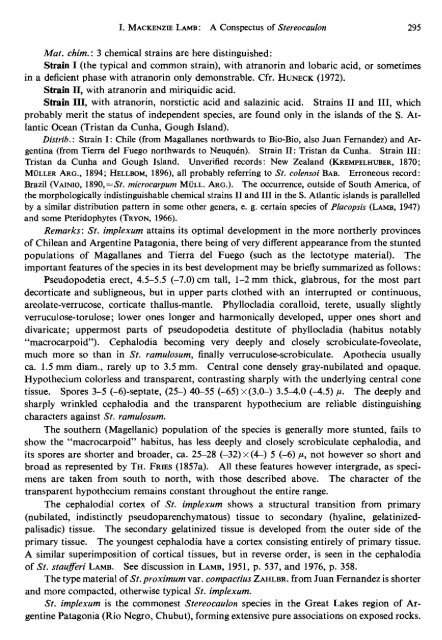A CONSPECTUS OF THE LICHEN GENUS STEREOCAULON ...
A CONSPECTUS OF THE LICHEN GENUS STEREOCAULON ...
A CONSPECTUS OF THE LICHEN GENUS STEREOCAULON ...
You also want an ePaper? Increase the reach of your titles
YUMPU automatically turns print PDFs into web optimized ePapers that Google loves.
I. MACKENZIE LAMB: A Conspectus of Stereocaulon 295<br />
Mat. chim. : 3 chemical strains are here distinguished:<br />
Strain I (the typical and common strain), with atranorin and lobaric acid, or sometimes<br />
in a deficient phase with atranorin only demonstrable. Cfr. HUNECK (1972).<br />
Strain 11, with atranorin and miriquidic acid.<br />
Strain III, with atranorin, norstictic acid and salazinic acid. Strains I1 and 111, which<br />
probably merit the status of independent species, are found only in the islands of the S. Atlantic<br />
Ocean (Tristan da Cunha, Gough Island).<br />
Distrib. : Strain I: Chile (from Magallanes northwards to Bio-Bio, also Juan Fernandez) and Argentina<br />
(from Tierra del Fuego northwards to NeuquCn). Strain 11: Tristan da Cunha. Strain 111:<br />
Tristan da Cunha and Gough Island. Unverified records: New Zealand (KREMPELHUBER, 1870;<br />
MULLER ARG., 1894; HELLBOM, 1896), all probably referring to St. colensoi BAB. Erroneous record:<br />
Brazil (VAINIO, 1890,=St. microcarpurn M~~LL. ARG.). The occurrence, outside of South America, of<br />
the morphologically indistinguishable chemical strains I1 and 111 in the S. Atlantic islands is parallelled<br />
by a similar distribution pattern in some other genera, e. g. certain species of Placopsis (LAMB, 1947)<br />
and some Pteridophytes (TRYON, 1966).<br />
Remarks: St. implexum attains its optimal development in the more northerly provinces<br />
of Chilean and Argentine Patagonia, there being of very different appearance from the stunted<br />
populations of Magallanes and Tierra del Fuego (such as the lectotype material). The<br />
important features of the species in its best development may be briefly summarized as follows:<br />
Pseudopodetia erect, 4.5-5.5 (-7.0) cm tall, 1-2 mm thick, glabrous, for the most part<br />
decorticate and subligneous, but in upper parts clothed with an interrupted or continuous,<br />
areolate-verrucose, corticate thallus-mantle. Phyllocladia coralloid, terete, usually slightly<br />
verruculose-torulose; lower ones longer and harmonically developed, upper ones short and<br />
divaricate; uppermost parts of pseudopodetia destitute of phyllocladia (habitus notably<br />
"macrocarpoid"). Cephalodia becoming very deeply and closely scrobiculate-foveolate,<br />
much more so than in St. ramulosum, finally verruculose-scrobiculate. Apothecia usually<br />
ca. 1.5 mm diam., rarely up to 3.5 mm. Central cone densely gray-nubilated and opaque.<br />
Hypothecium colorless and transparent, contrasting sharply with the underlying central cone<br />
tissue. Spores 3-5 (-6)-septate, (25-) 4&55 (-65) x(3.c) 3.54.0 (4.5) p. The deeply and<br />
sharply wrinkled cephalodia and the transparent hypothecium are reliable distinguishing<br />
characters against St. ramulosum.<br />
The southern (Magellanic) population of the species is generally more stunted, fails to<br />
show the "macrocarpoid" habitus, has less deeply and closely scrobiculate cephalodia, and<br />
its spores are shorter and broader, ca. 25-28 (-32) x (4) 5 (-6) p, not however so short and<br />
broad as represented by TH. FRIES (1857a). All these features however intergrade, as specimens<br />
are taken from south to north, with those described above. The character of the<br />
transparent hypothecium remains constant throughout the entire range.<br />
The cephalodial cortex of St. implexum shows a structural transition from primary<br />
(nubilated, indistinctly pseudoparenchymatous) tissue to secondary (hyaline, gelatinizedpalisadic)<br />
tissue. The secondary gelatinized tissue is developed from the outer side of the<br />
primary tissue. The youngest cephalodia have a cortex consisting entirely of primary tissue.<br />
A similar superimposition of cortical tissues, but in reverse order, is seen in the cephalodia<br />
of St. staufferi LAMB. See discussion in LAMB, 1951, p. 537, and 1976, p. 358.<br />
The type material of St. proximum var. compactius ZAHLBR. from Juan Fernandez is shorter<br />
and more compacted, otherwise typical St. implexum.<br />
St. implexum is the commonest Stereocaulon species in the Great Lakes region of Argentine<br />
Patagonia (Rio Negro, Chubut), forming extensive pure associations on exposed rocks.

















